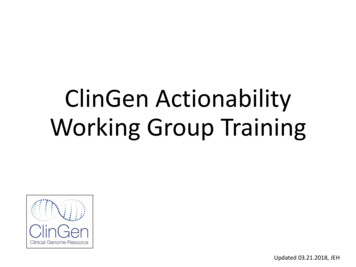
Transcription
ClinGen ActionabilityWorking Group TrainingUpdated 03.21.2018, JEH
Table of ContentsTraining Steps for New Scorers ClinGen Overview Actionability Working Group (AWG) Overview General AWG Methods Generation of a Summary Report Scoring a Topic Scoring Process Dissemination of AWG Reports and Scores Using the AWG Interface How to Access Confluence Additional Resources Slide34710152122303141502
Training Steps for New AWG Scorers Review the following materials: ClinGen Project Summary Report Protocol AWG Scoring Protocol Manuscript on AWG methods development and scoringof the ACMG56 Review these training slides Orientation call with Kristy Lee Listen in on a couple of AWG calls and practicescoring without entering scores into interface3
ClinGen: Clinical Genome Resource Launched in 2013 Co-funded by NHGRI, NICHD, and NCI Collaboration with NCBI’s ClinVar 250 researchers and clinicians from 75institutionsPurpose: To build an authoritative central resourcethat defines the clinical relevance of genes andvariants for use in precision medicine and research.4
ClinGen OverviewKey Goals Share genomic and phenotypic data provided byclinicians, researchers, and patients throughcentralized databases for clinical and research use Standardize clinical annotation and interpretationof genomic variants Implement evidence-based expert consensus forcurating genes and variants Improve understanding of variation in diversepopulations to realize interpretation of genetictesting on a global scale Develop machine-learning algorithms to improvethe throughput of variant interpretation Assess the “medical actionability” of genes andvariants Structure and provide access to genomicknowledge for use in EHR ecosystems Disseminate the collective knowledge andresources for unrestricted use in the communityClinGen Website: https://www.clinicalgenome.org/5
6
AWG: Actionability Working GroupThe overarching goal of the AWG is to identify those human genes that,when significantly altered, confer a high risk of serious disease that could beprevented or mitigated if the risk were known.Goals:1. Develop rigorous and standardized procedures for categoricallydefining “clinical actionability”; a concept that includes a knownability to intervene and thereby avert a poor outcome due to apreviously unsuspected high risk of disease2. Nominate genes and diseases to score for “clinical actionability”3. Produce evidence-based reports and semi-quantitative metricscores using a standardized method for nominated gene diseasepairs4. Make these reports and actionability scores publicly available toaid broad efforts for prioritizing those human genes with thegreatest relevance for clinical intervention.7
Clinical Context There are many points during a person’s life whengenomic information may be acted upon For the purposes of the AWG, the clinical context hasbeen defined as: An adult with an incidental or secondary finding identified viagenome-scale sequencing This person has not been previously diagnosed with thegenetic disorder However, this person may have signs or symptoms of thegenetic condition (e.g., the person may have high cholesteroland may be undergoing treatment for it, but does not knowthat they have familial hypercholesterolemia)8
Clinical Actionability There are many actions a person cantake afterreceiving genetic risk information For the purposes of the AWG, “clinical actionability” hasbeen defined as: Well-established, clinically prescribed interventions Interventions that are specific to the genetic disorder underconsideration (we do not consider general lifestyle and behavioralchanges that are recommended to the general population, with theexception of special cases, such as smoking cessation in a1antitrypsin deficiency) Lead to disease prevention or delayed onset, lowered clinicalburden, or improved clinical outcomes Though important, we do not current consider factors suchas personal utility, reproductive decision-making, andending the diagnostic odyssey9
Overview of the AWG WorkflowStep 1AWG selectsgenephenotype pairfor evaluationStep 2KSTassessesrapidrule-outcriteriaAWG decides ifan exceptionwill be madeYesStep 3KST preparessummaryreportNoSTOPStep 4AWG reviewspreliminary reportto determinewhether to provideother sources andselects outcomeintervention pairsfor scoringYesStep 6AWG: Actionability Working GroupKST: Knowledge Synthesis Team, asubset of AWG that curatesactionability evidence in summaryreportsAWG applies semiquantitative metricto generate scoresfor outcomeintervention pairsusing information inthe reportStep 5KST abstracts datafromsupplementalsources andincorporates intothe report10
Step 1:Selecting Gene-Disorder Pairs The pairings can include a single gene (e.g., APC and familialadenomatous polyposis) or bundles of genes that areassociated with the same disorder (e.g., MLH1, MSH2,MSH6, and PMS2 and Lynch syndrome) The AWG started with the list of genes recommended by theAmerican College of Medical Genetics and Genomics(ACMG) for return as secondary findings (e.g., ACMG56 andACMG 2.0 SF) Additional gene-disorder pairs assessed by the AWG havebeen nominated by AWG members and non-AWGstakeholders11
Step 2:KST Performs a Rapid Rule-Out AssessmentThe purpose of the rapid rule-out step is to quicklyrule-out from further consideration any genedisorder pair that does not meet 3 criteria:1. Actionability: Is the result actionable in an undiagnosedadult?2. Penetrance: Is there a pathogenic variant with at leastmoderate penetrance ( 40%)? [Penetrance is allowed tobe “unknown.”]3. Burden of disease: Is this an important health problem?12
13
Step 2:KST Performs a Rapid Rule-Out Assessment If the gene-disorder pair passes the rule-out criteria, itmoves automatically to generation of a summary report If the gene-disorder pair does not pass the rule-outcriteria, the AWG may decide that an exception shouldbe made to proceed to generation of a summary report An example may be if the penetrance is known to be low andis below the penetrance threshold, yet there are compellingreasons to consider it for scoring (e.g., Brugada syndrome didnot meet the penetrance threshold, but the outcome wasconsidered severe enough that an exception was made) If an exception is not made, the gene-disorder pair is notconsidered further at that time, but may be reassessedat a later time when additional evidence comesavailable14
Step 3:KST Generates the Summary ReportThe purpose of the summary report is to document andsummarize the available evidence related to key featuresof actionability KST evidence sources: The KST uses a detailed protocol to systematically identifyrelevant literature to make the process standardized andreproducible across curators The protocol to identify evidence is limited in scope to makethe process feasible: Evidence included: Clinical practice guidelines, systematicreviews, meta-analyses, OMIM, GeneReviews, OrphaNet,and Clinical Utility Gene Cards Evidence not included: Narrative reviews and primaryliterature15
Step 3:KST Generates the Summary ReportAll evidence identified by the KST for a gene-disorder pair istiered base on quality:Tier 1: Evidence from a systematic review, meta-analysis, orpractice guideline based on a systematic reviewTier 2: Evidence from a practice guideline or expert consensuswith some level of evidence reviewTier 3: Evidence from a non-systematic evidence review (e.g.,GeneReview or OMIM entry) with primary literature citedTier 4: Evidence from a non-systematic review of evidence(e.g., GeneReview or OMIM entry) with no citations toprimary data sourcesTier 5: Evidence from a non-systematically identified source(see slides 18 and 19)16
Step 3:KST Generates the Summary ReportThe KST abstracts data from the highest tiered sourcesavailable for 5 domains associated with clinicalactionability:1. Nature of the genetic disorder: Prevalence, clinicalfeatures, natural history2. Actionability: Patient management, surveillance,family management, and circumstances to avoid3. Likelihood: Prevalence of the associated geneticvariants, penetrance/relative risk, variable expressivity4. Nature of the intervention: risk and burden5. Chance to escape clinical detection prior to harm inthe clinical setting17
Step 3:KST Generates the Summary ReportTo ensure that the summary report contains all relevantinformation required to assign a score based on the SQM,additional sources may be identified by the KST tosupplement the report using a non-systematic method: These sources may include such sources as primaryliterature, references cited in MedGen, and websites ofrelevant major health organizations such as the CDC,American Cancer Society, or other trusted website Any information from these supplementary sourcesincluded in the summary report will be assigned a Tier 5(i.e., evidence not identified by the systematic evidencesearch)18
Step 4:AWG Reviews the Summary ReportOnce the KST generates a preliminary report, it is postedon Confluence for AWG review and comment with thegoals of: Assessment for accuracy Nomination of additional references References nominated by AWG members to incorporate intothe report are designated as Tier 5 Suggest specific outcomes and associated interventionsto be scored for actionability All topics are scored for specific outcome-intervention pairs,rather than the condition as a whole (e.g., colorectal cancerand colonoscopy for Lynch syndrome) See slides 39-47 on how to access Confluence19
Step 5:The KST Revises the Summary ReportAfter the AWG review, the KST revises the report to: Incorporate any suggested edits or nominatedreferences from the AWG Ensure there is sufficient evidence for theeffectiveness of interventions selected for scoring,if available20
Step 6:The AWG Applies the SQM to Generate Scores(Scoring is done in the AWG interface, see slides 28-38 on how to access the scoring interface)SEVERITYWhat is the nature of threat to health to individual carrying a clearly deleterious allele in this gene?3 Sudden death (e.g., Long QT syndrome)2 Death or major morbidity (e.g., Lynch syndrome)1 Modest morbidity0 Minimal or no morbidityLIKELIHOODWhat is the chance a serious outcome will materialize given a deleterious variant?3 40% chanceA Substantial evidence (Tier 1)2 5-39% chanceB Moderate evidence (Tier 2)1 1-4% chanceC Minimal evidence (Tier 3 or 4)0 1% chanceD Poor evidence, or missingE Expert contributions (Tier 5)EFFECTIVENESS How effective is intervention for preventing or significantly diminishing the risk of harm?3 Highly effectiveA Substantial evidence (Tier 1)2 Moderately effectiveB Moderate evidence (Tier 2)1 Minimally effectiveC Minimal evidence (Tier 3 or 4)0 Controversial or unknownD Poor evidence, or missingeffectivenessE Expert contributions (Tier 5)IN Ineffective*NATURE OFHow risky, medically burdensome or intensive is the intervention?INTERVENTION 3 Low risk, medically acceptable, and low intensity2 Moderate risk, moderately acceptable or intensive1 Greater risk, less acceptable and substantial0 High risk, poorly acceptable, or intensive21* If a score of IN is given, no scores are given for the other categories.
Scoring ProcessScorers are allowed to changetheir score after discussion withthe rest of the AWG scorersEach scorerprovides apreliminaryscoreScorediscussion onAWG callEach scorerprovides afinal scoreConsensusScoreThe consensus score isthe majority, but theindividual final scoresdon’t have to agree22
Points to Consider While Scoring The 4 domains of actionability are scored for eachoutcome-intervention pair for the gene-disorder Subgroups within the gene-disorder may be scoredseparately if they are known to differ across domainsconsidered for actionability. Subgroups may be definedby such variables as: Gene: BRCA1 and BRCA2 were scored separately due tovarying penetrance for ovarian cancer Sex: Hemophilia, an X-linked disorder, was scored separatelyfor males and females given the differences in severity Zygosity: Heterozygotes and homozygotes were scoredseparately for familial hypercholesterolemia due todifferences in interventions and severity23
Points to Consider While Scoring Always assume a maximally deleterious variant hasbeen identified When scoring effectiveness of an intervention,assume ideal adherence and access to care A score of ‘IN’ is given to an intervention wherethere is evidence provided that the intervention isNOT effective, whereas a score of ‘0’ is given wherethere is unclear or controversial evidence that anintervention is effective24
Points to Consider While Scoring The Nature of the Intervention domain assigns a score tohow risky, burdensome, or intensive an intervention is. Thisdomain is particularly subjective and context-dependent,and perspectives of the AWG may differ from perspectivesof a patient. Some examples for each Nature of the Interventioncategory are: 3 points: Non-invasive screening (e.g., ultrasonography,mammography), medications with low side effects, simple dietaryinterventions 2 points: CT scans with contrast (risks of radiation and contrast),catheterization for imaging, medications with tolerable but irksomeside effects, synthetic diets such as low protein 1 points: Prophylactic surgery with limited morbidity to removetarget organs, such as prophylactic mastectomy or oophorectomy 0 points: Removal of an organ with very high associated morbiditysuch as gastrectomy or pancreatectomy25
Points to Consider While Scoring All 4 domains are assigned a numerical score, whileLikelihood and Effectiveness are also assigned a letter scorebased on the tier of evidenceRating LabelASubstantial evidenceBCDEProposed DefinitionEvidence is provided in the report and is based on high tier evidence(Tier 1)Moderate evidenceEvidence is provided in the report and is based on moderate tierevidence (Tier 2)Minimal evidenceEvidence is provided in the report and is based on lower tierevidence (Tier 3 or 4)Poor evidence orEvidence is conflicting or not available and unable to be provided inconflictingthe reportSubjective evidence based Evidence that was not systematically identified, and only experton expert contributionsprovided evidence is available in the report (Tier 5)26
Points to Consider While Scoring Data on the effectiveness of a particular intervention can beextrapolated from experience with a similar condition when thereis a lack of data specific to the topic being scored When using extrapolated data, the number score will reflect itseffectiveness, but evidence score should be downgraded by a letter For example, the effectiveness of aortic aneurysm surveillance inMarfan syndrome was scored as “3B” based on available evidence;however, there was no evidence for this intervention in Loeys-Dietzsyndrome, so the effectiveness score was extrapolated from Marfansyndrome with the evidence score downgraded for a score of “3C” In addition, scorers can choose to override the available evidenceand give it a higher evidence score based on their expert opinion For example, a disorder may be given a score of 3A for likelihoodbased on expert opinion of the AWG when the evidence level in thesummary report indicates a score of 3C27
Points to Consider While Scoring When scoring the effectiveness of a surveillanceintervention, the effectiveness of the interventionconsidered is not limited to the effectiveness of thesurveillance mechanism to detect the outcome, but to allowfor the timely implementation of downstream treatments toreduce morbidity and mortality For example, for the effectiveness of mammography, do notconsider the ability of mammography to detect a tumor in thebreast alone (proximal effectiveness), but also consider theeffectiveness of mammography programs to reduce morbidity andmortality to allow for earlier detection and treatment for breastcancer (distal effectiveness)28
Dissemination of AWG Reports and Scores Once a topic has been completed, the summary report andconsensus scores become publicly available on the nabilityevidence-based-summaries/ These reports and consensus scores can be used bystakeholders to guide decision-making regarding the returnof secondary findings based on actionability The reports are not comprehensive and should be not beused to guide clinical care29
Scoring in the Actionability InterfaceThe next set of slides will show you how toaccess the AWG scoring interface to scoregene-disorder pairsIf you need login information or have troublelogging in, you may contact Jessica Hunter(Jessica.E.Hunter@kpchr.org) or Sai Subramanian(SaiLakshmi.Subramanian@bcm.edu)30
Step 1:Go to http://actionability.clinicalgenome.org/, click ‘ADULTAWG’ and enter in your login information.31
Step 2:Once logged in you should see the screen below, click the‘search’ button to retrieve entry result(s).32
Step 3:Find the topic assigned for scoring using the search box at thetop (use disorder name or gene).33
Step 4:When you find the topic, click on the edit button (the penciland paper icon on the far right).34
Step 5:Now you are at the first scoring page (Severity). Informationfrom the summary report is shown in the middle of thescreen. You will enter your scores on the right-hand side.Make sure you scroll down (grey bar at right) and score alloutcomes. Hit “Save” when you have completed this section.35
Step 6:To go to the next section for scoring, go to the menu on theleft side and select “Likelihood of outcome.” Make sure youscroll all the way down on the right side to ensure you havescored all outcomes. Save your scores when you are done.36
Step 7:Once you have completely scored each section, chose the“Summary” option in the left. Here you can review yourscores.37
Step 8:You may return to any section at this time to edit or enteradditional scores (be sure to save if you change your scores).Once you are happy with your scores, return to the summarypage, change the “Set My Score Status” to “Complete”, andclick “Save”.38
Step 9:To move on to the next topic, click on the icon highlightedbelow on the upper right-hand side (by the orange arrow) togo back to the topics page (shown in Step 2) and repeat.39
Step 10:When you are done, log out by using the “power” button onthe far right.40
ConfluenceThe next set of slides will show you how toaccess the Confluence interface to read andcomment on the reports.If you need login information or have troublelogging in, you may contact Melissa(landrum@ncbi.nlm.nih.gov)41
Step 1:Go to https://ncbiconfluence.ncbi.nlm.nih.gov/, enter in yourlogin information, and click “Log in.”42
Step 2:Under ‘Spaces,’ click ‘Space directory’ which will take you to a pagelisting many entities including ‘ClinGen.’ If ‘ClinGen’ is already listedunder ‘Spaces,’ click ‘ClinGen’ and proceed to slide 42.43
Step 3:Under ‘Site Spaces,’ click ‘ClinGen’ which will take you to a pagelisting many entities including ‘ClinGen;’ click on ‘ClinGen.’44
Step 4:Under ‘ClinGen Main Page,’ click ‘Actionability’ which will takeyou to the AWG page.’45
Step 5:Scroll down to ‘Working Documents,’ click ‘Summary Reports forReview by date’ which will display a clickable list of reports. Click onthe report of interest.46
Step 6:On the summary report page, clickable pdfs of the reports, reportsummaries and a comments section are available. Log out when done.47
Alternate:When it is time to review reports, Kristy Lee sends out emails withlinks directly to the reports. Click on the link, log in, and it willdirectly right to the report to review.48
Also on Confluence:There are a variety of AWG-related documents stored on the Actionabilitypage, includin
knowledge for use in EHR ecosystems Disseminate the collective knowledge and resources for unrestricted use in the community. 6. . Evidence from a systematic review, meta-analysis, or practice guideline based on a systematic review . references cited in MedGen, and website
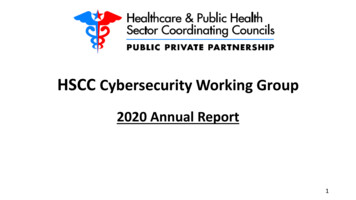
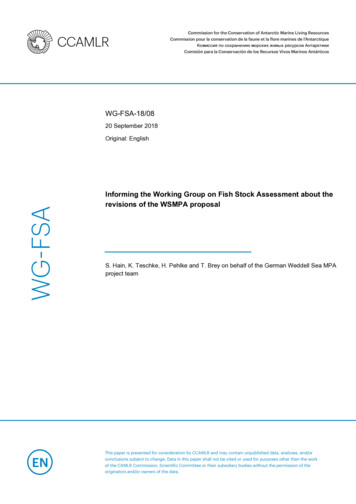

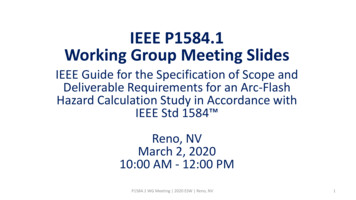
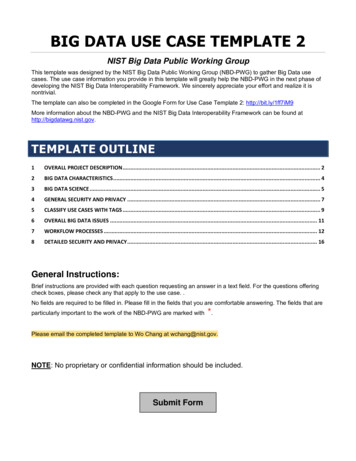
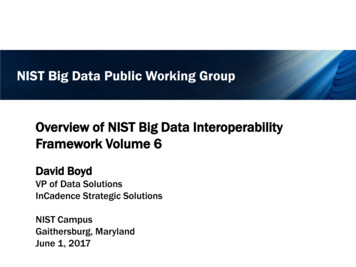
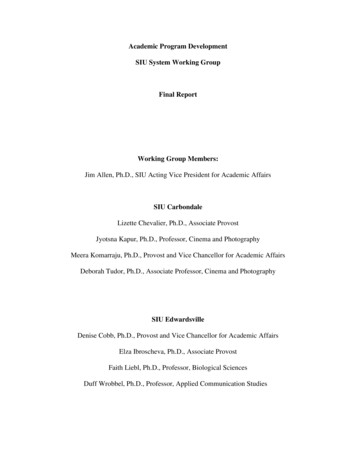
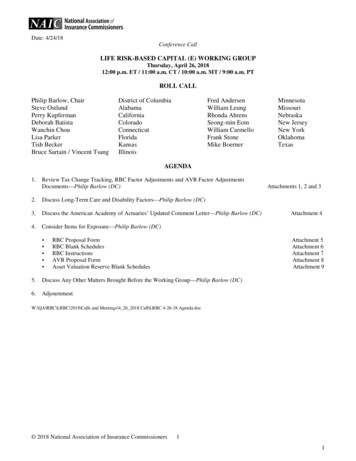
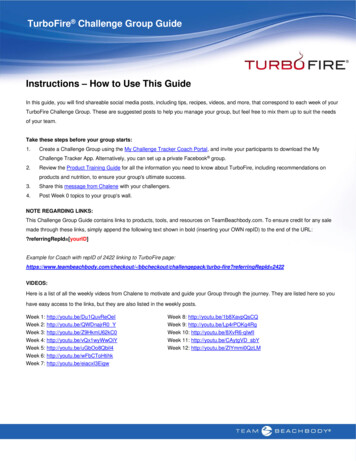
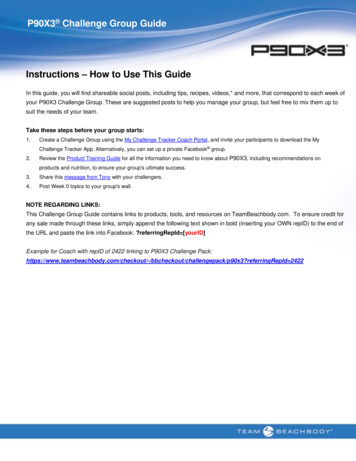
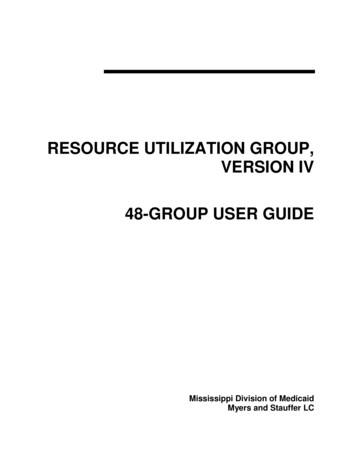
![Group 4 AggieService Client Training v1.pptx [Read-Only]](/img/9/group-204-20aggieservice-20client-20training-20v1-0.jpg)